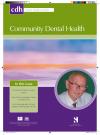Community Dental Health

- Cover Date:
- June 2013
- Print ISSN:
- 0265 539X
- Vol:
- 30
- Issue:
- 2
Sociodemographic differences in oral health-related quality of life related to dental caries in Thai school children
doi:10.1922/CDH_ 3007Krisdapong07
Objective: This study aimed to assess associations between sociodemographic and oral health behavioural factors with dental caries and oral health-related quality of life (OHRQoL) attributed to dental caries in a national representative sample of 12- and 15-year-old Thai children. Method: A representative subsample from the sixth Thailand National Oral Health Survey, 1,063 12-year-olds and 811 15-year-olds, completed a questionnaire on sociodemographic and behavioural information and were orally examined and interviewed about OHRQoL using the Child-OIDP or OIDP indexes. Associations of sociodemographic and behavioural factors with DMFT and Condition-Specific impacts (CS-impacts) attributed to dental caries were investigated using Chi-square tests and regressions. Results: For both groups, DMFT scores were associated with gender, geographic area and recently receiving dental treatment. Geographic area was the only sociobehavioural factor independently associated with CS-impacts. Dental caries accounted for the significant associations of sugary snacks and drinks consumption with CS-impacts. Significant associations of CS-impacts with consuming crispy snacks in 12-year-olds and fizzy drinks in 15-year-olds became non-significant when DT was entered into models. Conclusions: There were considerable geographic differences in DMFT and CS-impacts attributed to dental caries among Thai children.
Key words: adolescents, children, dental caries, oral health behaviour, quality of life, sociodemographic
- Article Price
- £15.00
- Institution Article Price
- £
- Page Start
- 112
- Page End
- 118
- Authors
- S. Krisdapong, P. Prasertsom, K. Rattanarangsima, A. Sheiham
Articles from this issue
- Title
- Pg. Start
- Pg. End
- Barriers and facilitators that influence the delivery of prevention guidance in health service dental practice: A questionnaire study of practising dentists in southwest England
- 71
- 76
- Care home managers’ views of dental services for older people living in nursing and residential homes in inner city London
- 77
- 82
- Automated coaching to help parents increase their children’s brushing frequency: an exploratory trial
- 88
- 93
- Operationalisation of the construct of access to dental care: a position paper and proposed conceptual definitions
- 94
- 101
- Sociodemographic differences in oral health-related quality of life related to dental caries in Thai school children
- 112
- 118
- Short Communication - The cross cultural adaptation and validity of the Child-OIDP scale among school children in Karnataka, South India
- 124
- 126
- Short Communication - Defluoridation techniques implemented by the government of Karnataka, India – the current situation
- 127
- 128
